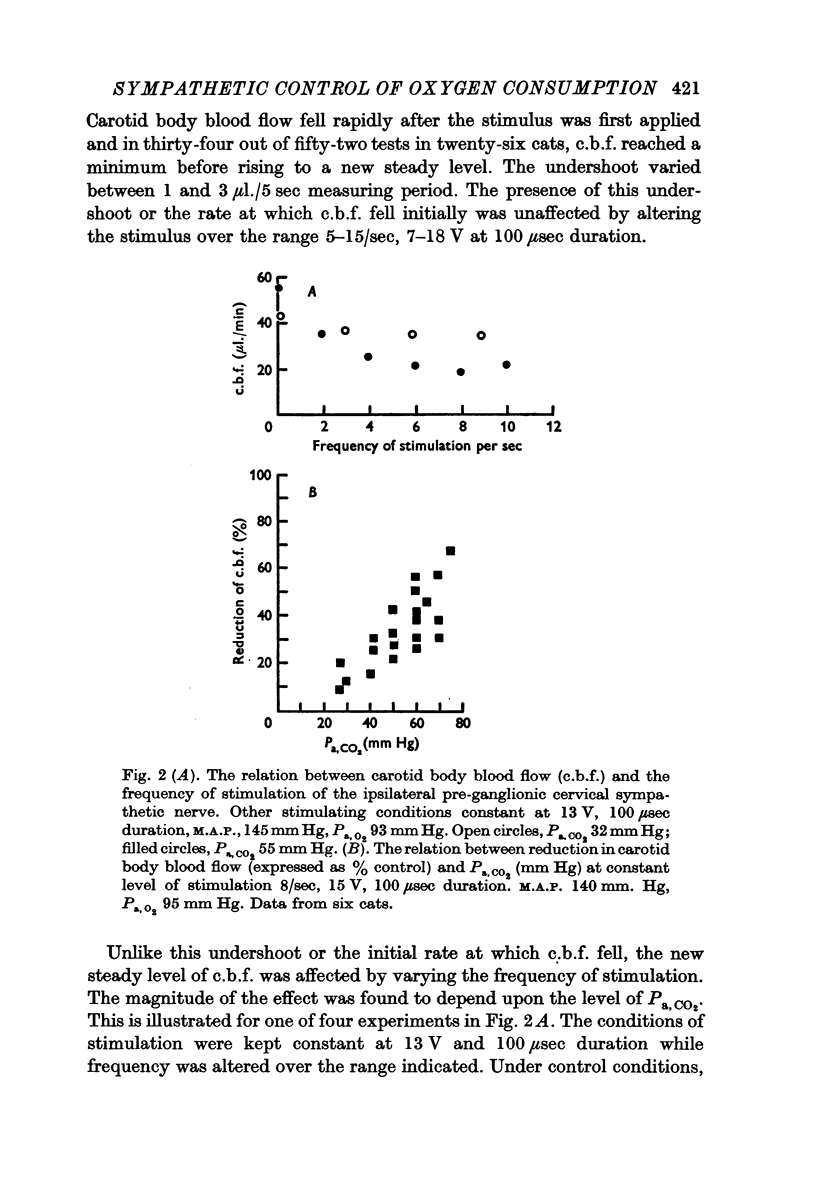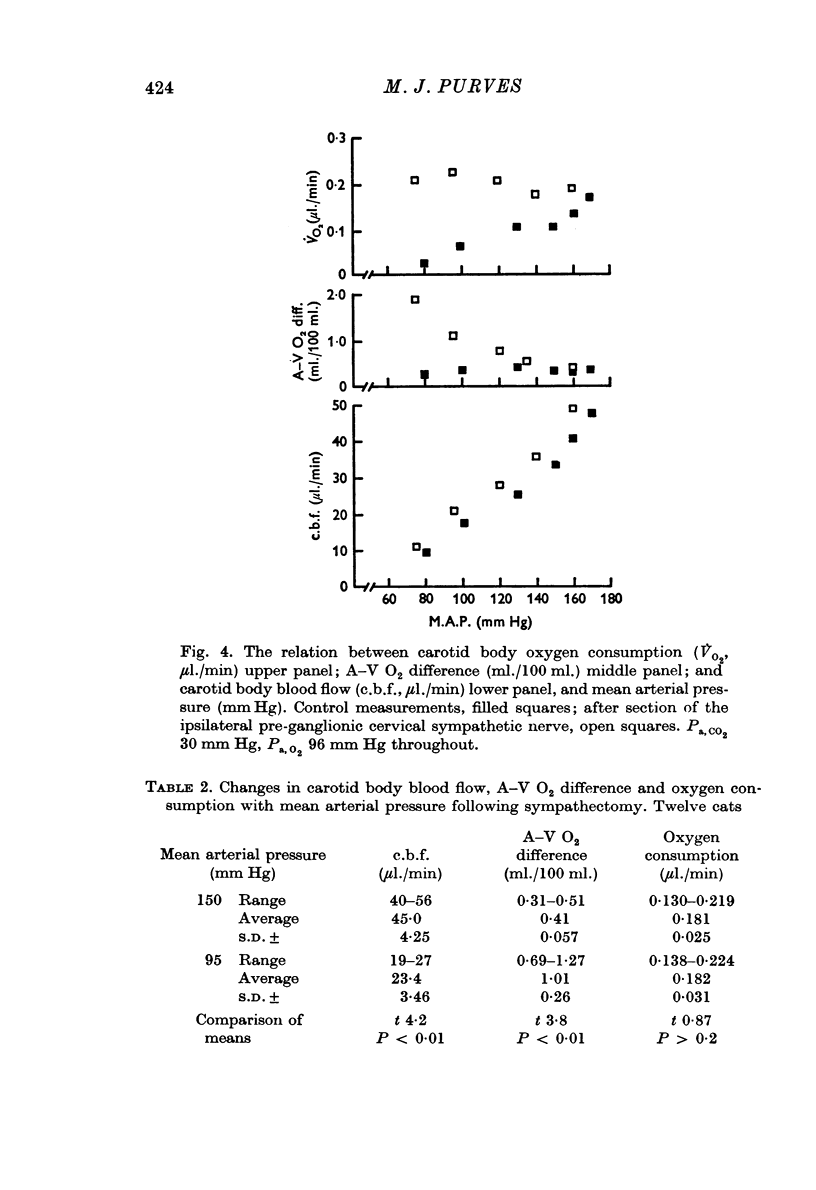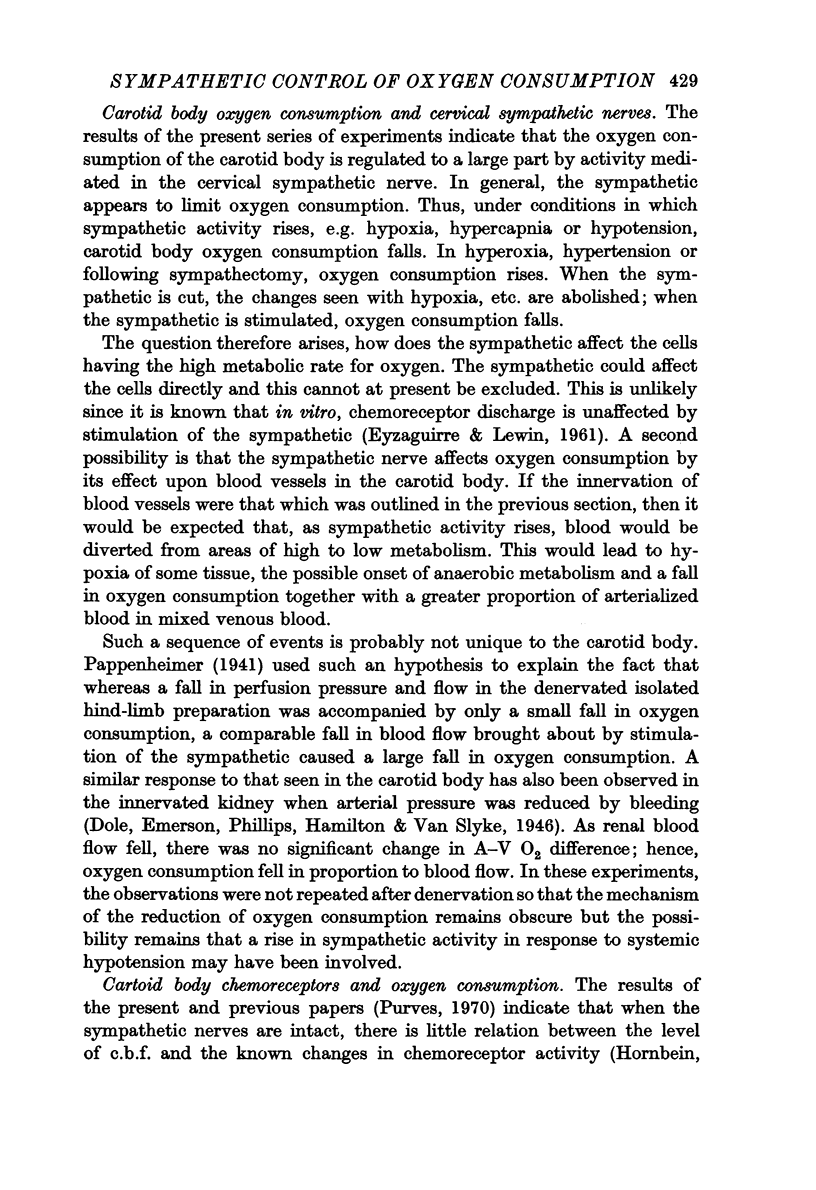Abstract
1. Carotid body blood flow (c.b.f.) and carotid arterial—carotid body venous oxygen (A—V O2) difference were measured and carotid body oxygen consumption calculated in twenty-six cats anaesthetized with pentobarbitone sodium, paralysed with gallamine triethiodide and ventilated mechanically.
2. With the sinus nerves intact and with blood gas tensions and carotid sinus pressure within physiological limits, section of either the pre- or post-ganglionic cervical sympathetic nerve on the same side caused an average rise in c.b.f. of 9·2 μl./min, in A—V O2 difference of 0·09 ml./100 ml. and in carotid body oxygen consumption of 0·075 μl./min.
3. When the pre- or post-ganglionic cervical sympathetic nerves were stimulated, c.b.f. and A—V O2 difference fell. The fall in c.b.f. was enhanced at high Pa, CO2; the fall in A—V O2 difference and in calculated oxygen consumption was enhanced at low mean arterial pressure (M.A.P.) or Pa, O2.
4. Following sympathectomy, a reduction of M.A.P. at constant Pa, O2 and Pa, CO2 caused a fall in c.b.f. and a commensurate rise in A—V O2 difference so that carotid body oxygen consumption remained approximately constant.
5. When Pa, O2 was altered over the range 35 to > 400 mm Hg, or Pa, CO2 over the range 27-70 mm Hg at constant M.A.P., c.b.f. changed by amounts which were similar to those observed when the sympathetic nerves were intact and A—V O2 difference changed in the opposite direction so that carotid body oxygen consumption similarly remained constant.
6. Comparison of these results with those observed when the sympathetic nerves were intact indicates that the sympathetic nerves exert a vasoconstrictor effect upon carotid body blood vessels over a wide range of blood gas tensions and arterial pressure and that they also tend to diminish the rate of carotid body oxygen consumption. The mechanisms which may be involved in this regulation are discussed.
Full text
PDF














Selected References
These references are in PubMed. This may not be the complete list of references from this article.
- Biscoe T. J., Purves M. J. Observations on carotid body chemoreceptor activity and cervical sympathetic discharge in the cat. J Physiol. 1967 Jun;190(3):413–424. doi: 10.1113/jphysiol.1967.sp008218. [DOI] [PMC free article] [PubMed] [Google Scholar]
- Biscoe T. J., Purves M. J., Sampson S. R. Types of nervous activity which may be recorded from the carotid sinus nerve in the sheep foetus. J Physiol. 1969 May;202(1):1–23. doi: 10.1113/jphysiol.1969.sp008792. [DOI] [PMC free article] [PubMed] [Google Scholar]
- Biscoe T. J., Sampson S. R. Stimulus response curves of single carotid body chemoreceptor afferent fibres. Nature. 1967 Aug 5;215(5101):654–655. doi: 10.1038/215654a0. [DOI] [PubMed] [Google Scholar]
- Colebatch H. J., Dawes G. S., Goodwin J. W., Nadeau R. A. The nervous control of the circulation in the foetal and newly expanded lungs of the lamb. J Physiol. 1965 Jun;178(3):544–562. doi: 10.1113/jphysiol.1965.sp007641. [DOI] [PMC free article] [PubMed] [Google Scholar]
- DE BURGH DALY M., LAMBERTSEN C. J., SCHWEITZER A. Observations on the volume of blood flow and oxygen utilization of the carotid body in the cat. J Physiol. 1954 Jul 28;125(1):67–89. doi: 10.1113/jphysiol.1954.sp005143. [DOI] [PMC free article] [PubMed] [Google Scholar]
- DE CASTRO F. Sur la structure de la synapse dans les chemocepteurs; leur mécanisme d'excitation et rôle dans la circulation sanguine locale. Acta Physiol Scand. 1951 Feb 21;22(1):14–43. doi: 10.1111/j.1748-1716.1951.tb00747.x. [DOI] [PubMed] [Google Scholar]
- EYZAGUIRRE C., LEWIN J. The effect of sympathetic stimulation on carotid nerve activity. J Physiol. 1961 Dec;159:251–267. doi: 10.1113/jphysiol.1961.sp006806. [DOI] [PMC free article] [PubMed] [Google Scholar]
- GIRLING F. Vasomotor effects of electrical stimulation. Am J Physiol. 1952 Jul;170(1):131–135. doi: 10.1152/ajplegacy.1952.170.1.131. [DOI] [PubMed] [Google Scholar]
- HORNBEIN T. F., GRIFFO Z. J., ROOS A. Quantitation of chemoreceptor activity: interrelation of hypoxia and hypercapnia. J Neurophysiol. 1961 Nov;24:561–568. doi: 10.1152/jn.1961.24.6.561. [DOI] [PubMed] [Google Scholar]
- James I. M., Millar R. A., Purves M. J. Observations on the extrinsic neural control of cerebral blood flow in the baboon. Circ Res. 1969 Jul;25(1):77–93. doi: 10.1161/01.res.25.1.77. [DOI] [PubMed] [Google Scholar]
- Neil E., O'Regan R. G. Effects of sinus and aortic nerve efferents on arterial chemoreceptor function. J Physiol. 1969 Jan;200(1):69P–71P. [PubMed] [Google Scholar]
- Pappenheimer J. R. Vasoconstrictor nerves and oxygen consumption in the isolated perfused hindlimb muscles of the dog. J Physiol. 1941 Jan 14;99(2):182–200. doi: 10.1113/jphysiol.1941.sp003892. [DOI] [PMC free article] [PubMed] [Google Scholar]
- Purves M. J. Changes in oxygen consumption of the carotid body of the cat. J Physiol. 1969 Feb;200(2):132P–133P. [PubMed] [Google Scholar]
- Purves M. J. The effect of hypoxia, hypercapnia and hypotension upon carotid body blood flow and oxygen consumption in the cat. J Physiol. 1970 Aug;209(2):395–416. doi: 10.1113/jphysiol.1970.sp009171. [DOI] [PMC free article] [PubMed] [Google Scholar]


